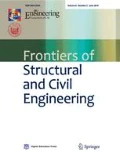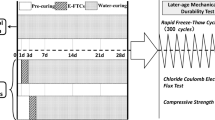Abstract
During the construction of lightweight cellular concrete (LCC), material damage frequently occurs, causing the degradation and deterioration of the mechanical performance, durability, and subgrade quality of LCC. The construction-induced damage can be more significant than those from the service environment of LCC, such as freeze-thaw (F—T) action in cold regions. However, the effect of construction-induced damage on LCC during F—T cycles is often ignored and the deterioration mechanisms are not yet clarified. In this study, we investigated the factors causing damage during construction using a sample preparation method established to simulate the damage in the laboratory setting. We conducted F—T cycle tests and microstructural characterization to study the effect of microstructural damage on the overall strength of LCC with different water contents under F—T actions. We established the relationship between the pore-area ratio and F—T cycle times, pore-area ratio, and strength, as well as the F—T cycle times and strength under different damage forms. The damage evolution is provided with the rationality of the damage equation, verified by comparing the measured and predicted damage variables. This study would serve as a guide for the construction and performance of LCC in cold regions.
Similar content being viewed by others
References
Mohd Sari K A, Mohammed Sani A R, Abdullah M A B, Abd Rahim S Z, Muhammad Suandi M E, Mat Saad M N. Applications of foamed lightweight Concrete, MATEC Web of Conferences, 2017, 97: 1–5
Chica L, Alzate A. Cellular concrete review: New trends for application in construction. Construction & Building Materials, 2019, 200: 637–647
Huang J, Su Q, Zhao W H, Li T, Zhang X. Experimental study on use of lightweight foam concrete as subgrade bed filler of ballastless track. Construction & Building Materials, 2017, 149: 911–920
Jones M R, McCarthy A. Behaviour and assessment of foamed concrete for construction applications. In: Proceedings of the International Conference on the Use of Foamed Concrete in Construction. Scotland: Thomas Telford Publishing, 2005: 61–88
Jiang J, Lu Z, Niu Y, Li J, Zhang Y. Study on the preparation and properties of high-porosity foamed concretes based on ordinary Portland cement. Materials & Design, 2016, 92: 949–959
Liu X, Ni C W, Zhang L Y, Sheng K, Hong B N. Durability assessment of lightweight cellular concrete in subgrade by the method of analytic hierarchy process combined with fuzzy comprehensive evaluation. Mathematical Problems in Engineering, 2019: 1–10
He X, Yin J, Yang J, Liang Q, Wu S. Effect of dry-wet circulation on moisture absorption of autoclaved aerated concrete. Advances in Materials Science and Engineering, 2019: 1–12
Neramitkornburi A, Horpibulsuk S, Shen S L, Chinkulkijniwat A, Arulrajah A, Disfani M M. Durability against wetting-drying cycles of sustainable lightweight cellular cemented construction material comprising clay and fly ash wastes. Construction & Building Materials, 2015, 77: 41–49
Kamei T, Takashima J I, Shibi T. Temperature effects on unconfined compressive strength and microstructure of foamed mixture lightweight soil containing flaked polyethylene terephthalate (PET). Soil and Foundation, 2008, 48(6): 833–842
Shon C S, Lee D, Kim J H, Chung C. Freezing and thawing resistance of cellular concrete containing binary and ternary cementitious mixtures. Construction & Building Materials, 2018, 168: 73–81
Liu X, Ni C W, Meng K, Zhang L Y, Liu D X, Sun L Z. Strengthening mechanism of lightweight cellular concrete filled with fly ash. Construction & Building Materials, 2020, 251: 118954
Luo Q, Liu D X, Qiao P, Feng Q G, Sun L Z. Microstructural damage characterization of concrete under freeze-thaw action. International Journal of Damage Mechanics, 2018, 27(10): 1551–1568
Dong Y, Su C, Qiao P, Sun L Z. Microstructural damage evolution and its effect on fracture behavior of concrete subjected to freeze-thaw cycles. International Journal of Damage Mechanics, 2018, 27(8): 1272–1288
Senbu O, Kamada E. Mechanism and evaluation method of frost deterioration of cellular concrete. In: Proceedings of the 5th International Conference on the Durability of Building Materials and Components. Brighton: Spon Press, 1990, 241–246
Tikalsky P J, Pospisil J, MacDonald W. A method for assessment of the freeze-thaw resistance of preformed foam cellular concrete. Cement and Concrete Research, 2004, 34(5): 889–893
Liu X, Gan L Q, Sheng K, Hong B N. Experimental study on service life of foamed mixture lightweight soil based on method of accelerated stress tests. Chinese Journal of Geotechnical Engineering, 2017, 39(10): 1793–1799
Ling Q, Yuan X D, Xuan Z W, Min D A. Study of initial damage and damage development of Concrete by compression test. Journal of Hefei University of Technology (Natural Science), 2001, 24(6): 1061–1065 (in Chinese)
Jones M R, McCarthy A. Preliminary views on the potential of foamed concrete as a structural material. Magazine of Concrete Research, 2005, 57(1): 21–31
Kearsley E P, Wainwright P J. Porosity and permeability of foamed concrete. Cement and Concrete Research, 2001, 31(5): 805–812
Indu Siva Ranjani G, Ramamurthy K. Behaviour of foam concrete under sulphate environments. Cement and Concrete Composites, 2012, 34(7): 825–834
Yea G G, Kim H Y. SanghyunHan. Material and behavior characteristics of lightweight embankment for road constructed on soft ground. Journal of the Korean Geosynthetics Society, 2018, 17(2): 41–49
Qiu Y Q, Li Y L, Li M X, Liu Y F, Zhang L J. Experimental study on microstructure characters of foamed lightweight soil. In: IOP Conference Series: Earth and Environmental Science. Bristol: IOP Publishing Ltd, 2018
Wang G C, Sha L, Jin F L. Study on the strength properties and failure mode of recycled sludge lightweight soil. Applied Mechanics and Materials, 2013, 275–277: 1281–1284
Cong M, Bing C. Properties of a foamed concrete with soil as filler. Construction & Building Materials, 2015, 76: 61–69
Yu X G, Gao Y N, Lin L, Li F. Influence of foaming agent on the properties of high density foam concrete. Advanced Materials Research, 2011, 399–401: 1214–1217
Ministry of Communications. Notice of the ministry of communications on the promulgation of the code of practice for highway geotechnical tests (JTG e40–2007). Urban Roads and Bridges & Flood Control, 2007, 9: 199 (in Chinese)
Ministry of Housing and Urban-Rural Development. CJJ/T 177–2012: Technical Specification for Foamed Mixture Lightweight Soil Filling Engineering. Beijing: China Architecture & Building Press, 2012 (in Chinese)
Liu X, Ni C W, Ji H, Tan S Y, Hong B N. Construction techniques and quality test and evaluation of lightweight cellular concrete mixed with fly ash as subgrade material. Advances in Materials Science and Engineering, 2019, 2019(4): 1–12
ASTM. Standard Test Methods for Freezing and Thawing Compacted Soil-Cement Mixtures, ASTM D560/D560M-16. West Conshohocken, PA, 2016
He G, Zheng Y R, Yang C X. Characteristics of water absorption and frost thawing resistance to foamed cement banking. Journal of Logistical Engineering University, 2008, 24(4): 6–8 + 34 (in Chinese)
Zhang C L, Huang J C, Xiong Y S, Yang G, Yan S L. Durability of foamed cement banking with raw soil. Journal of Wuhan University of Technology, 2014, 36(8): 32–36
Acknowledgements
This study was sponsored by the National Natural Science Foundation of China (Grant No. 51609071) and the Fundamental Research Funds for the Central Universities (No. B200202087, B200204032). Xin Liu’s study at UC Irvine was supported by the China Scholarship Council (No. 201806715014).
Author information
Authors and Affiliations
Corresponding authors
Rights and permissions
About this article
Cite this article
Liu, X., Zhang, L., Shao, Z. et al. Influence of construction-induced damage on the degradation of freeze—thawed lightweight cellular concrete. Front. Struct. Civ. Eng. 15, 781–792 (2021). https://doi.org/10.1007/s11709-021-0733-9
Received:
Accepted:
Published:
Issue Date:
DOI: https://doi.org/10.1007/s11709-021-0733-9




